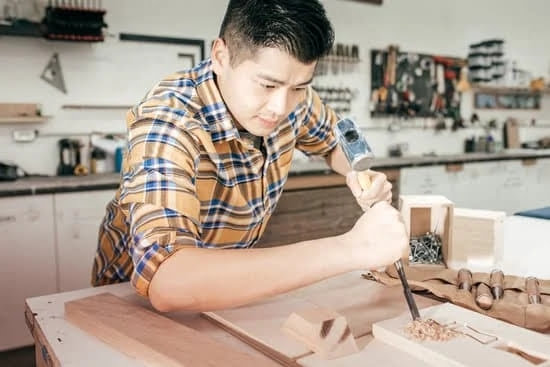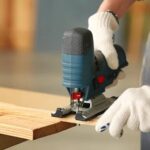Woodwork is a beautiful addition to any home, but without proper waterproofing, it can quickly deteriorate when exposed to the elements. In this article, we will explore how to finish woodwork to make it waterproof, ensuring its longevity and durability. Whether you’re working on an outdoor deck, furniture, or any other wood project, understanding the process and choosing the right products is essential for protecting the wood from moisture damage.
Wooden surfaces are prone to water damage, leading to rotting, warping, and discoloration over time. By applying a waterproof finish, you can safeguard the wood from these issues and maintain its natural beauty for years to come. From understanding different types of wood and their natural resistance to water to choosing the right waterproofing products and applying them correctly, we will cover all the essential steps and considerations in achieving effective waterproofing.
Properly finishing woodwork not only ensures its resistance to water but also enhances its overall appearance and longevity. The key is in understanding the process and taking the time to select the appropriate materials for your specific project. So, let’s dive into the world of finishing woodwork for waterproofing and explore how you can protect your wood creations from moisture damage.
Understanding Wood Types
Different Types of Wood and Their Natural Resistance to Water
When it comes to finishing woodwork to make it waterproof, the type of wood being used plays a crucial role in the process. Some types of wood naturally have more resistance to water than others. For example, cedar and redwood are known for their natural ability to repel water, making them excellent choices for outdoor woodwork projects. On the other hand, woods like pine or fir are less resistant and will require proper waterproofing treatment to prevent damage from moisture.
Factors to Consider When Choosing the Type of Wood for Waterproof Finishing
In addition to natural resistance, there are several factors that should be considered when choosing the type of wood for a waterproof finishing project. The intended use of the woodwork, the climate in which it will be placed, and the specific aesthetic qualities desired all play a role in selecting the appropriate wood. Understanding these factors is essential for achieving long-lasting results when finishing woodwork to make it waterproof.
When choosing a type of wood for waterproofing, it’s important to also consider its ease of maintenance. Some types of wood may require more frequent re-finishing than others, so this aspect can impact the overall choice when seeking durability. In conclusion, understanding the different types of wood and their unique characteristics is fundamental before taking on a project that requires waterproofing.
Impact of Different Wood Types on Waterproofing Products
The type of wood being used will also affect which waterproofing products are most suitable. It is important to choose products that complement or enhance the natural properties of the chosen wood while providing adequate protection against moisture. Failure to do so could result in an ineffective finish and potential damage over time.
Preparing the Wood Surface
Before applying any waterproof finish to your woodwork, it is crucial to properly prepare the wood surface. This step is essential for ensuring that the waterproofing product adheres effectively and provides long-lasting protection against moisture. Here’s a step-by-step guide on how to prepare the wood surface for waterproof finishing.
Inspecting and Cleaning the Wood
To begin, carefully inspect the wood for any imperfections such as cracks, knots, or raised grain. These imperfections should be addressed before applying any waterproofing product. Use a fine-grit sandpaper to smooth out any rough areas and ensure that the wood surface is clean and free from dust, dirt, and debris.
Filling and Sealing
For wooden surfaces with visible cracks or holes, it is important to fill these areas with an appropriate wood filler. Once filled, allow the wood filler to dry completely before sanding the surface smooth. After filling any imperfections, use a quality wood sealer to seal the entire surface. This step helps to prevent moisture from penetrating the wood and ensures even absorption of the waterproofing product.
Applying a Pre-Stain Conditioner
In some cases, particularly with softwoods like pine, it may be necessary to apply a pre-stain conditioner before adding a waterproof finish. This conditioner helps to create a more uniform appearance by reducing blotchiness caused by uneven stain absorption. It also prepares the wood for better adhesion of the waterproofing product.
By following these steps and taking great care in preparing the wood surface, you can ensure that your water-resistant finish will be effectively applied and provide long-lasting protection against moisture. Proper preparation is key in achieving a durable and effective waterproofed result for your woodwork project.
Whether you are working on outdoor furniture or indoor cabinetry, understanding how to finish your work with complete water resistance can significantly prolong its life span while preserving its overall aesthetic appeal.
Choosing the Right Waterproofing Products
When it comes to finishing woodwork to make it waterproof, choosing the right waterproofing product is crucial for achieving the desired results. There are various options available, each with its own advantages and considerations. Below is a comparison of different types of waterproofing products to help you make an informed decision for your specific woodwork project.
- Sealants: Sealants are a popular choice for waterproofing woodwork due to their ability to form a protective barrier against moisture. They come in various forms such as polyurethane or silicone-based sealants, and can provide long-lasting waterproofing when applied correctly.
- Varnishes: Varnishes are another common option for waterproofing wood. They typically contain resins that create a durable finish, making them suitable for both indoor and outdoor use. It’s important to choose a varnish specifically designed for waterproofing to ensure proper protection.
- Oils: Wood oils offer a more natural approach to waterproofing, penetrating the wood fibers to repel water and prevent damage. Different types of oils, such as linseed oil or teak oil, provide varying levels of protection and can enhance the natural beauty of the wood.
When choosing the right waterproofing product for your woodwork project, consider factors such as the intended use of the item, the type of wood being used, and the desired level of protection. Additionally, take into account the application process and maintenance requirements associated with each type of product.
Ultimately, selecting the appropriate waterproofing product is essential in ensuring that your woodwork remains protected from water damage for years to come. With the wide range of options available, you can find the perfect solution to achieve a durable and resilient finish that preserves the beauty and integrity of your woodwork.
Applying the Waterproof Finish
When it comes to finishing woodwork to make it waterproof, applying the right waterproofing product is crucial in ensuring the longevity and effectiveness of the finish. There are several options to choose from, including sealants, varnishes, and oils, each with its own set of pros and cons.
Sealants are great for providing a clear, protective layer on the surface of the wood, while varnishes offer a durable and glossy finish. On the other hand, oils penetrate deep into the wood, providing a natural look while also enhancing water resistance.
Before applying the waterproof finish, it is important to ensure that the wood surface is clean and free from any dust or debris. This can be achieved by sanding the wood lightly with fine-grit sandpaper and wiping it down with a tack cloth.
Once the surface is prepared, carefully follow the instructions provided by the manufacturer of the chosen waterproofing product for application. Whether using a brush, roller, or spray method, make sure to apply an even coat of the product and allow it to dry fully between multiple coats.
One essential tip for achieving a smooth and effective waterproof finish is to work in a well-ventilated area with proper protective gear such as gloves and a mask to avoid any potential health hazards associated with certain types of waterproofing products. Additionally, be mindful of temperature and humidity conditions as they can affect drying times and overall results.
By following these steps for applying the waterproof finish correctly, you can ensure that your woodwork will be protected from water damage for years to come.
| Waterproofing Product | Application Method |
|---|---|
| Sealants | Brush or roller |
| Varnishes | Brush or spray |
| Oils | Brush or cloth |
Sanding and Re-Application
Woodwork, when used for outdoor projects such as decks, furniture, or fences, needs to be properly finished to make it waterproof. This prevents damage from moisture and extends the lifespan of the wood. In this section, we will delve into the crucial steps of sanding and re-application in order to achieve a durable and long-lasting waterproof finish.
After applying the initial coat of waterproofing product, it is essential to sand the wood surface before re-applying another coat. Sanding between coats helps remove any rough spots or imperfections, ensuring that the subsequent layers adhere properly. Use fine-grit sandpaper to lightly sand the entire surface, working in the direction of the wood grain. This step not only smoothens out the finish but also promotes better adhesion for the next coat.
Once the first coat has been sanded, it’s time to proceed with re-application. Following the manufacturer’s instructions on drying times is important, typically requiring 24 hours before adding another layer of waterproof finish. Apply an even layer of sealant, varnish, or oil using a high-quality brush or applicator suitable for the specific product chosen. Be sure to work methodically and evenly across the surface in order to achieve consistent coverage.
Repeating this process for multiple coats will significantly increase the level of waterproof protection for your woodwork project. The number of coats necessary will depend on factors such as weather exposure and type of wood used. After completing all coats and allowing sufficient drying time as per instructions, testing can be done to ensure effectiveness before moving on to maintenance and care.
| Step | Description |
|---|---|
| Sanding | Lightly sand entire surface with fine-grit sandpaper in direction of wood grain |
| Re-Application | Allow for proper drying time before applying even layers of chosen waterproofing product |
Testing the Waterproofing
When it comes to finishing woodwork to make it waterproof, testing the effectiveness of the waterproof finish is crucial in ensuring that the wood is properly protected from moisture and other environmental elements. There are several methods for testing the waterproofing of woodwork, and each method can provide valuable insights into the overall quality of the finish. Here are some effective ways to test the waterproofing of your woodwork:
- Water Droplet Test: One simple way to test the effectiveness of a waterproof finish is to place a few droplets of water on the surface of the wood. If the water beads up and forms droplets on the surface, it indicates that the finish is still repelling moisture effectively. However, if the water begins to soak into the wood, it may be time to reapply or reinforce the waterproof finish.
- Soak Test: Another method involves soaking a small section of the wood in water for an extended period, such as 24 hours. After soaking, check for any signs of water absorption or damage to the wood fibers. If the wood remains unaffected by the water exposure, it indicates that the waterproof finish is holding up well.
- Moisture Meter Test: Using a moisture meter designed for wood materials can provide more precise measurements of moisture content within the wood. By comparing readings before and after applying a waterproof finish, you can determine how effectively the finish has reduced moisture absorption.
It’s important to note that while these tests can help determine if your woodwork is adequately protected from water damage, regular maintenance and care are also essential for preserving the waterproof finish over time.
To identify and address any areas that may need additional waterproofing, visually inspect all surfaces for signs of wear or damage. Look for areas where water may be penetrating or where the protective layer appears to be thinning out. These areas should be gently sanded and then recoated with an appropriate waterproofing product following the manufacturer’s guidelines.
By regularly testing and maintaining your woodwork’s waterproofing, you can ensure that it remains durable and attractive for years to come.
Maintenance and Care
After finishing the woodwork to make it waterproof, it is crucial to understand the importance of proper maintenance and care to ensure the longevity of the waterproof finish. The key to preserving the waterproofing is to regularly maintain and care for the woodwork to protect it from natural elements such as rain, moisture, and sunlight. By following these maintenance tips, you can extend the lifespan of the waterproof finish and keep your woodwork looking beautiful for years to come.
One important aspect of maintenance is regular cleaning. Use a mild soap and water solution to gently clean the surface of the woodwork, removing any dirt or debris that may have accumulated. Avoid using harsh chemicals or abrasive cleaners as they can damage the waterproof finish. Additionally, consider applying a new coat of waterproofing product every 1-2 years, depending on the level of exposure to outdoor elements.
Another essential maintenance task is inspecting the woodwork periodically for any signs of wear or damage to the waterproof finish. Look for any areas where water may be penetrating or where the finish may be wearing away. Addressing these issues promptly can prevent further damage and prolong the effectiveness of the waterproofing. If needed, re-apply the chosen waterproofing product according to the manufacturer’s instructions, ensuring that all surfaces are adequately protected.
In addition to regular cleaning and inspection, it is also important to protect your woodwork from prolonged exposure to harsh weather conditions. Consider using protective covers or shelters for outdoor furniture and structures, and avoid placing objects directly on finished surfaces that could cause scratches or wear down the waterproof finish over time. By following these maintenance and care tips, you can keep your woodwork well-protected and looking its best for years to come.
Conclusion
In conclusion, finishing woodwork to make it waterproof is an essential step in preserving the integrity and beauty of any wooden project. By understanding the different types of wood and their natural resistance to water, as well as properly preparing the wood surface, one can ensure a long-lasting waterproof finish. Additionally, choosing the right waterproofing products and applying them correctly are crucial for achieving the desired level of protection.
The process of finishing woodwork to make it waterproof involves careful consideration of various factors, such as the type of wood being used and the specific requirements of the project. Whether one opts for sealants, varnishes, or oils, it is important to follow the instructions carefully and take into account the environmental conditions in which the woodwork will be placed.
For those looking to embark on a woodworking project, it is recommended to explore different techniques and products for waterproof finishing. By following the steps outlined in this article and taking care to maintain and preserve the waterproof finish over time, individuals can enjoy their wooden creations for years to come. With proper knowledge and attention to detail, anyone can learn how to finish woodwork to make it waterproof and protect their projects from moisture damage.
Frequently Asked Questions
How Do You Finish Wood to Waterproof?
To finish wood to make it waterproof, you can use a variety of methods and products. One option is to use a clear, exterior-grade waterproof sealant that is specifically designed for wood.
This will create a protective barrier against moisture and prevent water from seeping into the wood. Another option is to use a marine-grade varnish or polyurethane, which is designed to withstand exposure to water and other outdoor elements.
What Is the Best Natural Waterproof Finish for Wood?
The best natural waterproof finish for wood is often considered to be tung oil. Tung oil is a natural product derived from the seeds of the tung tree, and it provides excellent protection against moisture while also enhancing the natural beauty of the wood.
It penetrates deeply into the wood fibers, creating a durable and waterproof finish that resists water damage.
How Do You Seal Wood for Outdoors?
When sealing wood for outdoor use, it’s important to choose a high-quality exterior sealant or finishing product that is specifically designed for outdoor applications. Before applying the sealant, make sure the wood is clean, dry, and free from any previous finishes or coatings.
Apply the sealant according to the manufacturer’s instructions, making sure to coat all surfaces thoroughly. Reapply as needed according to the recommended maintenance schedule for maximum protection against outdoor elements.

Hi everyone! I’m a woodworker and blogger, and this is my woodworking blog. In my blog, I share tips and tricks for woodworkers of all skill levels, as well as project ideas that you can try yourself.





